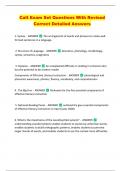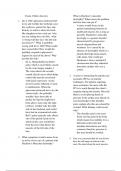Calt Exam Set Questions With Revised
Correct Detailed Answers
1. Syntax - ANSWER The arrangement of words and phrases to create well-
formed sentences in a language.
2. Structure of Language - ANSWER phonetics, phonology, morphology,
syntax, semantics, pragmatics
3. Dyslexia - ANSWER An unexplained difficulty in reading in someone who
has the potential to be a better reader
Components of Effective Literacy Instruction - ANSWER phonological and
phonemic awareness, phonics, fluency, vocabulary, and comprehension
4. The Big Five - ANSWER Nickname for the five essential components of
effective literacy instruction
5. National Reading Panel - ANSWER outlined the give essential components
of effective literacy instruction in report (year 2000)
6. What is the importance of the sound/symbol system? - ANSWER
understanding sounds/symbols enables students to sound out unfamiliar words,
enables students to build orthographic patterns, enables students to perceive
larger chunks of words, and enables students to use the context more efficiently
, 7. Sound/symbol foundation - ANSWER phonemic awareness and instant
letter recognition
8. Alphabetic Principle - ANSWER a phoneme is represented by a grapheme
9. Phoneme - ANSWER smallest unit of sound in a word which effects
meaning
10. Grapheme - ANSWER letter or group of letters used to represent one
sound
11. Reading and Written Expressive Language - ANSWER the two
components of Literacy Instruction
12. Decoding and Comprehension - ANSWER the two components of reading
13. Mechanics and Composition/Creativity - ANSWER the two components of
Written Expressive Language
14. Opportunities and Direct Instruction - ANSWER the two components of
instruction
15. Decoding - ANSWER instant word recognition, phonemic awareness,
sound/symbol association (instant letter recognition), structural analysis, context
,16. Listening Comprehension - ANSWER oral language (most important!),
world knowledge, strategic thinking, inference making
17. Fluency - ANSWER bridge between decoding and comprehension
18. Comprehension - ANSWER the ultimate goal of reading
19. Instant Word Recognition - ANSWER acquired through repeated
exposure to the word and from over learning the patterns of language
20. Mechanics - ANSWER sentence structure, paragraph structure, spelling,
handwriting (writer should be comfortable with spelling and handwriting)
21. Composition/creativity - ANSWER oral language, world knowledge,
strategic thinking, inference making
22. Direct instruction components - ANSWER Multisensory teaching and
discovery teaching
23. Domains of language - ANSWER phonology, pragmatics, orthography,
semantics, syntax, morphology
24. Interactive components of language - ANSWER Form, content (great
ideas), use (spelling, grammar, etc.)
, 25. Which domains fall into form component of language? - ANSWER
Phonology, Morphology, Syntax, orthography
Which domain falls into the content component of language? - ANSWER
semantics
Which domain falls into the use component of language? - ANSWER
pragmatics
Orthography is the only domain - ANSWER not developed orally first-starts at
the written level with spelling
phonology - ANSWER refers to the SOUND STRUCTURE of a langauge; how
sounds operate. It is the unconscious set of rules that govern speech.
Euphony - ANSWER pleasant sound; when words are formed or combined to
please the ear
phonological awareness - ANSWER knowledge of and sensitivity to the
BROAD SOUND STRUCTURE OF LANGUAGE
Examples of phonological awareness activities - ANSWER rhyming,
alliteration, counting words in sentences, counting syllables in words, omitting
syllables, phonemic awareness
Examples of phonemic awareness activities - ANSWER identifying sounds in a
word, segmenting, blending, changing sounds in words, omitting sounds in words





